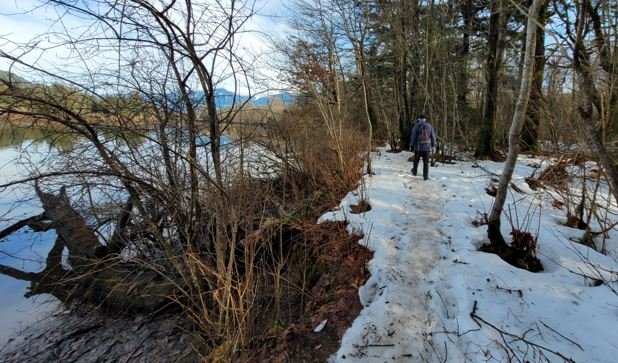
At five km in length, the Swan trail offers old-growth trees, placid river sloughs and frequent wildlife sightings. The trail starts at the Railway bridge over the Mamquam River and goes south to the estuary.
The Swan trail takes its name from the Trumpeter swans that can be found in Crescent slough from January to March. There have been five pairs of swans stopping here for a rest on their annual migration from the Arctic to the nesting site near Courtenay on Vancouver island.
Our area is protected by the Migratory Bird Convention and is also within the Sk’welwil’em Wildlife Management Area , which includes most of the estuary. The swans are shy birds and do not need human interference, and it is especially important that dogs be on leash.
The Swan trail has become even more popular since the densification of our downtown. Four thousand more residents have not been given any additional recreational facilities. This has led to vastly more people on the estuary trails of which the Swan trail is the main connector.
The northern portion of the trail has been repaired and improved over the past five years. Trail volunteers and the SORCA trails crew resurfaced the section from Buckley road south to the old Westbarr log sort, now the Westfield area.
Leader Excavations improved the section from Buckley road north to the Squamish river dike over the past two years. This leaves the southern 1 km from Westfielf to the Blue Heron trail to be brought up to safe standard.
And here, trail volunteers have hit immovable bureaucracy .
The Squamish Estuary Management Committee, led by the Squamish River Watershed Society, has reclaimed the old Wetbarr site and is pushing forward with the Central Estuary Restoration Project. The long-term goal is to improve the survivability of juvenile salmon by getting the estuary back to its original state. This revitalization of the rearing area is critical to the survival of local salmon.
However, the present section of the trail from Westfield southward was constructed as part of the revitalization project. All was well until a gale on a king tide washed away three parts in December 2018. Efforts to repair this damage have been denied by the provincial authority overseeing the Wildlife Management Area. Some political capital should be expended to make safety repairs to this popular trail.
Jim Gracie is a director with the Squamish Trails Society.





